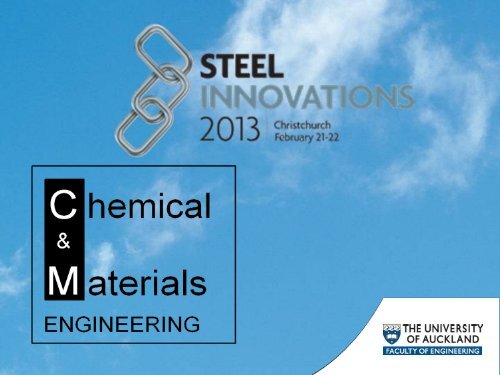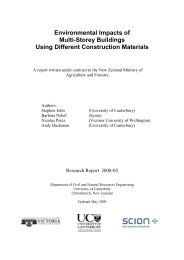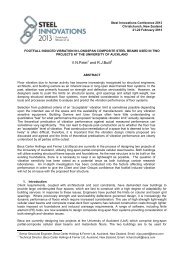Paper 9.1 - Steel Innovations Conference 2013 Christchurch-Ver4.pdf
Paper 9.1 - Steel Innovations Conference 2013 Christchurch-Ver4.pdf
Paper 9.1 - Steel Innovations Conference 2013 Christchurch-Ver4.pdf
Create successful ePaper yourself
Turn your PDF publications into a flip-book with our unique Google optimized e-Paper software.
The Performance and Remnant Life of Structural<br />
<strong>Steel</strong> in an Earthquake Damaged Building<br />
W. G. Ferguson 1 , H. Nashid 2 , G.C. Clifton 3 ,<br />
M V Kral 4 , S. Lopert 5 and G MacRae 6<br />
PART A<br />
W. George Ferguson<br />
Department of Chemical & Materials<br />
Engineering
Pacific Tower<br />
<strong>Steel</strong> Framed Building<br />
22 Storied<br />
Eccentrically Braced Framed<br />
(EBF) Seismic resisting system
Eccentrically Braced Frame (EBF)<br />
K - Type
Earthquake Resistant Construction<br />
• <strong>Steel</strong> framed structures performed well during the <strong>Christchurch</strong><br />
• Inelastic/plastic deformation was less than predicted<br />
• A design philosophy is to have structural elements (eg. EBFs’)<br />
deforming plastically and absorbing energy<br />
• Some EBFs’ sustained significant plastic deformation<br />
• How much more plastic strain can these elements absorb?<br />
• The question is “to replace the deformed EBF or not to replace the<br />
deformed EBF” that is the question?<br />
• This aspect is examined in the Pacific Tower
Structural <strong>Steel</strong><br />
• 153 years since Bessemer set up a <strong>Steel</strong> Company in Sheffield<br />
• <strong>Steel</strong> more plentiful, less expensive and available for structures<br />
• Open Hearth method used for higher quality steel<br />
• Electric Arc and Oxygen processes are modern methods<br />
• Late 1800’s, maximum limits for phosphorous, P, & sulphur, S<br />
• Early 1900’s impact tests for toughness in use<br />
• After WWII increased weldability important<br />
• Also need for increased strength, ductility & toughness
Modern Structural <strong>Steel</strong><br />
• Strengthening structural steel by<br />
- grain refinement (reduce size)<br />
- solid solution strengthening<br />
- precipitation hardening<br />
• Increase Toughness & reduce Transition Temp. by<br />
- grain size reduction<br />
• These achieved by Al treatment, addition of micro-alloying<br />
elements, Nb, V & Ti together with controlled rolling.
Lamellar Tearing – RBNZ 1974<br />
Sulphur reduction & inclusion shape control<br />
• Beam-Column Joint doubler plate weld doubler plate<br />
•<br />
Weld HAZ Fracture Surface
AS/NZS 3678:2011 Structural <strong>Steel</strong> (plates & slabs)
Certificate of Analysis and Mechanical Test
Plastic Strain Determination<br />
Determine plastic strain in a deformed Structure<br />
• Strain gauges and extensometers – when deforming<br />
• Digital imaging – no pattern on beam<br />
• Magnetic Barkhausen Noise – not developed<br />
• Hardness Test – material must work harden<br />
- Rockwell & Leeb (portable) Hardness Testers<br />
- Hardness tests show scatter<br />
- Method has established use in Nuclear Industry<br />
- <strong>Steel</strong> deformed to various plastic strains<br />
hardness measured<br />
hardness correlated with either strain or flow stress
Hardness Technique<br />
Grade 300Mpa steel<br />
Tensile specimens<br />
Plastic strained<br />
Rockwell B hardness
Rockwell B Hardness – Plastic strain<br />
Correlation
EBF – Web Plastic Strain<br />
- testing zones A B, & C<br />
- tensile specimen locations<br />
- hardness test grid pattern for zones A, B & C
Rockwell B versus Grid Numbers<br />
for Zones A, B & C ( Leeb tester)
Hardness versus Normalised Beam Depth<br />
for Zones A, B & C (Rockwell & Leeb testers)<br />
Note: - for zones B & C plastic strain near flanges<br />
- for zone A plastic strain constant across web
Stress – Strain Curves<br />
for zones A, B & C<br />
- tensile test results confirm hardness behaviour<br />
- as received plastic strain near flanges of about 3%<br />
- active link, zone A, plastic strain about 7 – 7.5%
- paint peeled off centre of web<br />
- plastic strain in centre of web<br />
Active Link
Beam X–Section Hardness Traverse<br />
- results Tide 16<br />
- as received plastic strain caused by cold flange straightening
Toughness of Pre-strained <strong>Steel</strong><br />
• <strong>Steel</strong> 310UC158 G300+<br />
Specimens taken from<br />
25mm thick column flanges<br />
• <strong>Steel</strong> pre-strained in<br />
uni – axial tension<br />
– 4.9%, 9.8% & 17.7%<br />
• Specimens prepared from<br />
pre-strained material for:<br />
Charpy V-Notch CVN,<br />
tensile and CTOD, testing at<br />
various temperatures.<br />
• Naturally Aged for at least<br />
2 months<br />
C Mn Si S P Ni V Nb Ti Al N<br />
0.17 1.47 0.10 0.014 0.017 0.007 0.001 0.001 0.001 0.025 0.0064<br />
Table 1 Mill certificate chemical analysis of 300Plus 310UC158, wt-%
Charpy V – Notch Transition Curves<br />
- effect of plastic prestrain<br />
- transition temperature increases with increasing prestrain
Conclusions<br />
• Need knowledge of Standards & <strong>Steel</strong> Mill Certificates<br />
• Hardness technique for determining plastic strain is credible<br />
• Portable Leeb hardness tester can give consistent results<br />
• The hardness variations in EBF link confirmed by tensile tests.<br />
• Testing must be done in the centre of the beam web<br />
• There was about 7 – 7.5% plastic strain in the active link beam.<br />
• Pre-existing plastic strain near the flanges produced by low<br />
temperature roll straightening of the flanges - strain was about 3%.<br />
• <strong>Steel</strong> plastically deformed 7.5% would still just meet 70 J at 0˚C
Thank you
Tensile Properties<br />
-at 10˚C<br />
- significant increase strain aged yield stress<br />
4.9 %<br />
9.8%<br />
17.7%

















